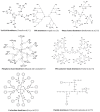Cytotoxicity of Dendrimers
- PMID: 31374911
- PMCID: PMC6723213
- DOI: 10.3390/biom9080330
Cytotoxicity of Dendrimers
Abstract
Drug delivery systems are molecular platforms in which an active compound is packed into or loaded on a biocompatible nanoparticle. Such a solution improves the activity of the applied drug or decreases its side effects. Dendrimers are promising molecular platforms for drug delivery due to their unique properties. These macromolecules are known for their defined size, shape, and molecular weight, as well as their monodispersity, the presence of the void space, tailorable structure, internalization by cells, selectivity toward cells and intracellular components, protection of guest molecules, and controllable release of the cargo. Dendrimers were tested as carriers of various molecules and, simultaneously, their toxicity was examined using different cell lines. It was discovered that, in general, dendrimer cytotoxicity depended on the generation, the number of surface groups, and the nature of terminal moieties (anionic, neutral, or cationic). Higher cytotoxicity occurred for higher-generation dendrimers and for dendrimers with positive charges on the surface. In order to decrease the cytotoxicity of dendrimers, scientists started to introduce different chemical modifications on the periphery of the nanomolecule. Dendrimers grafted with polyethylene glycol (PEG), acetyl groups, carbohydrates, and other moieties did not affect cell viability, or did so only slightly, while still maintaining other advantageous properties. Dendrimers clearly have great potential for wide utilization as drug and gene carriers. Moreover, some dendrimers have biological properties per se, being anti-fungal, anti-bacterial, or toxic to cancer cells without affecting normal cells. Therefore, intrinsic cytotoxicity is a comprehensive problem and should be considered individually depending on the potential destination of the nanoparticle.
Keywords: cytotoxicity; dendrimers; drug delivery; macromolecules; nanoparticles; toxicity.
Conflict of interest statement
The authors declare no conflict of interest.
Figures





Similar articles
-
Pharmaceutical and biomedical potential of surface engineered dendrimers.Crit Rev Ther Drug Carrier Syst. 2007;24(3):257-306. doi: 10.1615/critrevtherdrugcarriersyst.v24.i3.20. Crit Rev Ther Drug Carrier Syst. 2007. PMID: 17956215 Review.
-
Mechanistic insight into cell growth, internalization, and cytotoxicity of PAMAM dendrimers.Biomacromolecules. 2010 Feb 8;11(2):382-9. doi: 10.1021/bm9010134. Biomacromolecules. 2010. PMID: 20038138
-
Understanding specific and nonspecific toxicities: a requirement for the development of dendrimer-based pharmaceuticals.Wiley Interdiscip Rev Nanomed Nanobiotechnol. 2010 May-Jun;2(3):249-59. doi: 10.1002/wnan.79. Wiley Interdiscip Rev Nanomed Nanobiotechnol. 2010. PMID: 20166124 Free PMC article. Review.
-
Dendrimer toxicity: Let's meet the challenge.Int J Pharm. 2010 Jul 15;394(1-2):122-42. doi: 10.1016/j.ijpharm.2010.04.027. Epub 2010 Apr 28. Int J Pharm. 2010. PMID: 20433913 Review.
-
Ultrafast in situ forming poly(ethylene glycol)-poly(amido amine) hydrogels with tunable drug release properties via controllable degradation rates.Eur J Pharm Biopharm. 2019 Jun;139:232-239. doi: 10.1016/j.ejpb.2019.04.006. Epub 2019 Apr 4. Eur J Pharm Biopharm. 2019. PMID: 30954658
Cited by
-
New Insights in Psoriasis Management using Herbal Drug Nanocarriers.Curr Pharm Des. 2024;30(32):2550-2561. doi: 10.2174/0113816128330298240708110336. Curr Pharm Des. 2024. PMID: 39051579 Review.
-
A Molecular Dynamics Simulation of Complexes of Fullerenes and Lysine-Based Peptide Dendrimers with and without Glycine Spacers.Int J Mol Sci. 2024 Jan 5;25(2):691. doi: 10.3390/ijms25020691. Int J Mol Sci. 2024. PMID: 38255765 Free PMC article.
-
Synergistic Suppression of NF1 Malignant Peripheral Nerve Sheath Tumor Cell Growth in Culture and Orthotopic Xenografts by Combinational Treatment with Statin and Prodrug Farnesyltransferase Inhibitor PAMAM G4 Dendrimers.Cancers (Basel). 2023 Dec 23;16(1):89. doi: 10.3390/cancers16010089. Cancers (Basel). 2023. PMID: 38201517 Free PMC article.
-
Strategies, Challenges, and Prospects of Nanoparticles in Gynecological Malignancies.ACS Omega. 2024 Aug 23;9(36):37459-37504. doi: 10.1021/acsomega.4c04573. eCollection 2024 Sep 10. ACS Omega. 2024. PMID: 39281920 Free PMC article. Review.
-
Mucoadhesive Dendrons Conjugated to Mesoporous Silica Nanoparticles as a Drug Delivery Approach for Orally Administered Biopharmaceuticals.ACS Appl Mater Interfaces. 2023 Feb 22;15(7):8798-8810. doi: 10.1021/acsami.2c16502. Epub 2023 Feb 7. ACS Appl Mater Interfaces. 2023. PMID: 36749788 Free PMC article.
References
-
- Tomalia D.A., Baker H., Dewald J., Hall M., Kallos G., Martin S., Smith P. New Class of Polymers: Starburst-Dendritic Macromolecules. Polym. J. 1985;17:117–132. doi: 10.1295/polymj.17.117. - DOI
-
- Newkome G.R., Yao Z., Baker G.R., Gupta V.K. Cascade molecules: A new approach to micelles. A [27]-arborol. J. Org. Chem. 1985;50:2003–2004. doi: 10.1021/jo00211a052. - DOI
-
- Buhleier E., Wehner W., Vögtle F. “Cascade”- and “Nonskid-Chain-like” Syntheses of Molecular Cavity Topologies. Synthesis. 1978;2:155–158. doi: 10.1055/s-1978-24702. - DOI
-
- Klajnert B., Bryszewska M. Dendrimers: Properties and applications. Acta Biochim. Pol. 2001;48:199–208. - PubMed
Publication types
MeSH terms
Substances
LinkOut - more resources
Full Text Sources
Other Literature Sources

